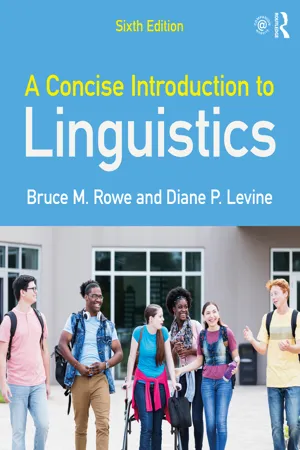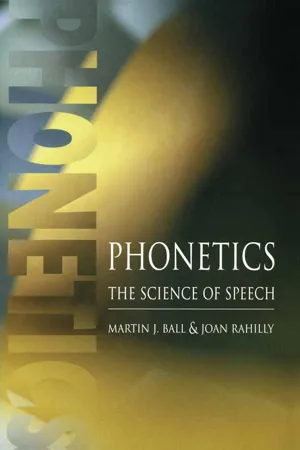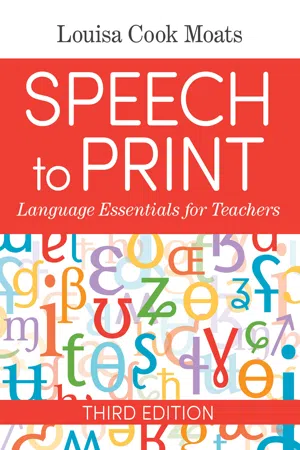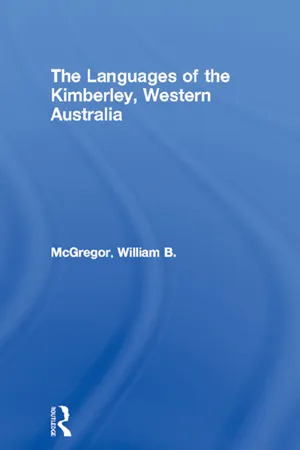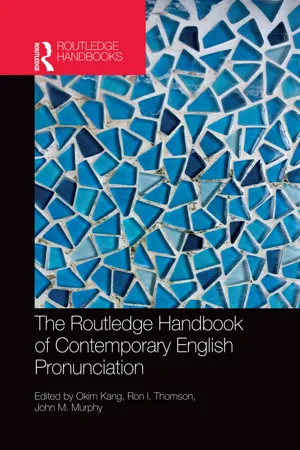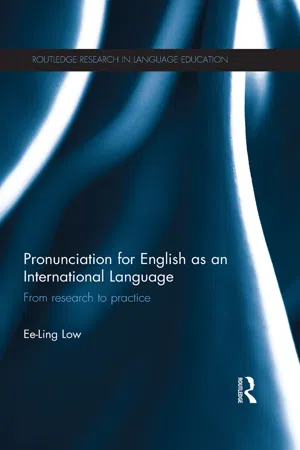Languages & Linguistics
Click Consonants
Click consonants are speech sounds produced by creating a pocket of air in the mouth and then releasing it in a way that produces a sharp clicking noise. These sounds are found in various languages, particularly in southern Africa and parts of the Americas, and are known for their distinctive and percussive quality. They are produced by using the tongue to create different types of clicks.
Written by Perlego with AI-assistance
7 Key excerpts on "Click Consonants"
- eBook - ePub
- Bruce M. Rowe, Diane P. Levine(Authors)
- 2022(Publication Date)
- Routledge(Publisher)
www.phonetics.ucla.edu/index/sounds.html .EXERCISE 1 Consonants I- The following are definitions of sounds in terms of manner and place of articulation, as well as voicing. Give the phonetic symbol for each sound defined and an example of a word in which each sound is used.
Phonetic symbol Example of word a. Voiced bilabial stop b. Voiced bilabial nasal _____________ _____________ c. Voiceless glottal stop _____________ _____________ d. Voiced labiodental fricative _____________ _____________ e. Voiced alveolar stop _____________ _____________ f. Voiceless palatal affricate _____________ _____________ g. Voiced alveolar lateral _____________ _____________ h. Voiced velar stop _____________ _____________ i. Voiceless velar stop _____________ _____________ j. Voiced dental fricative _____________ _____________ - This exercise deals with the relationship of the phonetic alphabet to the English alphabet.
- List the phonetic symbols for consonants that are usually pronounced essentially the same as they are in orthography (spelling).
- What English alphabetic symbols for consonants are used in the phonetic alphabet but are used differently in the English alphabet?
- What symbols used in the phonetic alphabet for consonants are not equivalent to any of the symbols in the English alphabet?
- List the phonetic symbols for consonants that are usually pronounced essentially the same as they are in orthography (spelling).
- eBook - ePub
Phonetics
The Science of Speech
- Martin J Ball, Joan Rahilly(Authors)
- 2014(Publication Date)
- Routledge(Publisher)
The so-called simple clicks do, in fact, involve a combination between a velar closure (i.e. [k]) and the click place of articulation: although of course the [k] is not heard as it is overlapped by the click sound itself. In other instances, the accompaniment is heard. In transcribing click sounds therefore it is now usual to combine the [k] with the click symbol for a ‘simple click’ (using the tie-bar diacritic to show simultaneous articulation; see Chapter 7), and relevant other symbols for other combinations. Some of these can be seen in Table 4.9. Khoisan languages in particular can show a very large number of possible click combinations, and so to illustrate click use in language, we restrict ourselves to just some examples from !Xóõ as displayed in Table 4.10 (analysed by Traill, reported in Ladefoged and Maddieson, 1996). The account of |Gui given by Nakagawa (1996) also demonstrates how complex click systems can be. Table 4.9 Some click combinations Table 4.10 Clicks in !Xó õ Further reading Again, we recommend phonetics texts such as Abercrombie (1967), Brosnahan and Malmberg (1970), Catford (1977, 1988), Clark and Yallop (1995), Ladefoged (1993) and Laver (1994) for an examination of obstruents, with Laver (1994) providing the most detailed account. Ladefoged and Maddieson (1996) illustrate a wide range of obstruents in different languages. Short questions 1 What consonants count as obstruents? 2 What are the three phases of the stop? Illustrate with diagrams. 3 Describe nasal and lateral release of stops with examples from English. 4 Describe the main ways in which fricatives can be sub-divided. 5 What is aspiration? Comment on stops and phonation. 6 How do trills and taps/flaps differ? 7 Describe the sequence of events needed to produce affricates. 8 How can Click Consonants be combined with other articulatory events? Essay questions 1 Describe the three stages of stop production and the range of modifications that can take place at these stages - eBook - ePub
Speech to Print
Language Essentials for Teachers
- Louisa Cook Moats(Author)
- 2020(Publication Date)
- Brookes Publishing(Publisher)
chair must be represented by /ch/). With the phonetic alphabet, only one unique symbol is used for each phoneme, with the exception of the affricate sounds (see the description that follows in the section on “Manner of Articulation”). In this book, the major listings of consonants and vowels are given in both symbol systems (phonic representation and IPA). Brackets [ ] are used to denote the surface phonetic transcription of a word’s pronunciation, and slashes / / are used to denote phonemes. Some phonetic segments, including the unstressed vowel sound (schwa) and the glottal stop, are not phonemes.Speech sounds are produced with movements of the tongue, lips, and throat. Air is pushed up from the lungs through an opening in the vocal cords (the glottis) and then through the throat, mouth, and nose. Air is more obstructed in consonant production than in vowel production. Thus, we can say for instructional purposes that consonants are “closed” sounds and vowels are “open” sounds. Figure 2.1 shows the speech apparatus.CONSONANTS AND THEIR DISTINGUISHING FEATURESConsonants are a class of speech sounds that are not vowels and that are formed with the mouth partially closed and the airflow obstructed by the lips, teeth, and tongue. Not all consonants, however, involve obstruction of the air stream to an equal degree; some consonants have vowel-like qualities (for example, the [m] in rhythm). Consonants with full obstruction of the air flow are called obstruents, and consonants with more vowel-like resonance are called sonorants.Consonants are distinguished by place and manner of articulation. Place of articulation refers to where the sound is made, or the position of the lips, teeth, and tongue in the front, middle, or back of the mouth. Manner of articulation refers to how the sound is made, or the production of airflow through the mouth. Where and how each sound is made constitutes a set of distinctive features. - eBook - ePub
Phonology in English Language Teaching
An International Approach
- Martha C. Pennington(Author)
- 2014(Publication Date)
- Routledge(Publisher)
2 ConsonantsCharacteristics of consonantsThe nature of consonants
Consonants are sounds made with closed or nearly closed articulations. As a consequence, they tend to break up the stream up speech, defining a perceptual and articulatory “edge”, or margin, for a unit (word or syllable in a word) that includes one or more vowels. Complex margins are made of two or more consonants. In English, both initial and final margins may include multiple consonants – up to three initially and up to four finally, as in:
The number and complexity of cluster types in English presents an area of difficulty for many non-native speakers./p/ pill /sp/ spill /pr/ pram /spr/ spray /t/ till /st/ still /tr/ tram /str/ stray /k/ kill /sk/ skill /kr/ cram /skr/ scray /p/ sap /lp/ whelp /rp/ harp /p/ sap /lt/ welt /rt/ heart /k/ sack /lk/ whelk /rk/ hark /lps/ whelps /rps/ corpse /lts/ welts /rts/ courts /lks/ whelks /rks/ corks /lpt/ sculpt /rst/ burst /lpts/ sculpts /rsts/ bursts Place of articulation
The vocal tract is divided into different regions which are used to describe the place of articulation of individual consonants and vowels, i.e. segmental sounds. The terms for the vocal organs and regions used for the production of speech sounds are shown in Figure 2.1 . The locations of these organs and regions are shown in Figure 2.2 .
FIGURE 2.1. Names of vocal organs and articulatory regionsVocal organs and articulatory regions (nouns) Adjectives nose nasal mouth oral lips labial teeth dental alveoli (or alveolar ridge or gum ridge) alveolar (hard) palate paltal velum (or soft palate) velar pharynx pharyngeal uvula uvula larynx (or vocal folds) laryngeal glottis glottal Tongue: apex (or tip) apical blade blade side lateral front front (laminai) center central back back root root Speech articulations are made primarily in the oral chamber, or oral tract, that is, in the area between the epiglottis and the lips. The most forward, or front, position in the oral tract is at the lips. The farthest back - William B. McGregor(Author)
- 2013(Publication Date)
- Routledge(Publisher)
4 PHONETICS AND PHONOLOGY4.1 Types of soundsIn all human languages most speech sounds are produced by pushing air out of the lungs, through the GLOTTIS or voice box, and then through either the mouth or the nose. The glottis contains the vocal cords or folds, which if held together not too tightly as the air passes through them, will vibrate, giving rise to voicing. These vibrations can be felt by holding your Adam’s apple between your thumb and first finger, and making the sounds mm and aa. Speech sounds that are accompanied by voicing are said to be VOICED ; all others are VOICELESS . The mouth and nose cavities also have an important role: by modifying the stream of air passing through in various ways, production of a range of different sounds is possible.The sounds of human languages fall into two main groups: CONSONANTS and VOWELS . Consonants are made with a noticeable obstruction of the airstream between the glottis and the outside air. For vowels, by contrast, the air passes unimpeded through the mouth. Compare, for instance, the two sounds in the English word fee. The first, the consonant f, is made with the upper teeth touching the bottom lip, while air is forced through this narrow opening, thereby producing audible friction. The second, the vowel written ee, does not involve obstruction anywhere in the mouth, and the sound comes out ‘purely’. You will also notice that the vocal cords are vibrating for the vowel ee, but not for the consonant f. Vowels are normally voiced.Consonants are classified according to the MANNER by which they are produced, and the PLACE- Okim Kang, Ron I. Thomson, John M. Murphy, Okim Kang, Ron I. Thomson, John M Murphy(Authors)
- 2017(Publication Date)
- Routledge(Publisher)
The chapter will first explain how speech sounds are made and then describe how English vowels and consonants sounds are produced. It will then show how phonemes can vary in context, particularly in different regional and national varieties of English. Finally, it will consider how important phonemes are for intelligibility and conclude with some recommendations for pronunciation learning.Producing speech sounds
All English sounds are produced by expelling air from the lungs through the mouth and/or nose. The part of the anatomy involved in speech production, from the lungs to the mouth or nose, is called the ‘vocal tract’ and the different speech organs within the vocal tract are referred to as ‘articulators’. The articulators are the different parts of the vocal tract that can change the shape of the air flow as it escapes through either the mouth or nose.Figure 6.1 shows diagrammatically each of the articulators in the vocal tract.Figure 6.1 The vocal tract and articulatorsFigure 6.2 Sections of the tongueThe tongue is perhaps the most important of all the articulators and can itself be divided into different sections, as shown in Figure 6.2 , which can move to change the shape of the space within the mouth, i.e. ‘the oral cavity’.Consonants
Producing consonants
Generally, we can describe the way consonant sounds are produced in terms of:- (a) place of articulation – i.e. where the sounds are produced in the vocal tract;
- (b) manner of articulation – i.e. how they are produced;
- (C) voicing – i.e. whether or not there is vibration of the vocal cords/folds.
Place of articulation
There are eight possible places of articulation for English consonants, as shown in Table 6.1 . We will now look at each point of articulation in turn.1 Bilabial: /b/ /p/ /m/
The upper and lower lips come together, e.g. /p/ as in <p an>; /b/ in <b an>; /m/ in <m at>; /w/ in <w et>.2 Labio-dental: /f/ /v/
The lower lip makes contact with the upper teeth, e.g. /f/ in <f an>; /v/ in <v- eBook - ePub
Pronunciation for English as an International Language
From research to practice
- Ee-Ling Low(Author)
- 2014(Publication Date)
- Routledge(Publisher)
5 Consonants DOI: 10.4324/9781315814131-5Chapter 2 has given a detailed coverage of what is involved in a full description of the articulation of consonants, namely voicing, place and manner of articulation. Crystal (2008 , p. 103) considers describing the voicing, place and manner to be part of the phonetic description of consonants but it is also important to point out that consonants, unlike vowels, do have a constriction in the airflow caused by the contact with the articulators and, for this reason, we are able to be very specific about their place and manner of articulation. This also makes it easy, if required, to point others to specific places and manner of articulation for producing specific consonants when learning a new language. This chapter will first talk about some phonological aspects of describing consonants in English, then go on to point out what recent research has shown about consonants in different varieties of English in the Outer and Expanding Circles, first starting with the overview offered by Mesthrie (2004) and then moving on to more recent acoustic studies on consonants in varieties spoken in these two circles. Finally, a discussion of the implications of the research findings for pronunciation practice for EIL will be elucidated.Phonological description of consonants
As mentioned in Chapter 4 , unlike vowels, consonants do not form the syllable nuclei. Instead, in English, initial and final consonant clusters do not constitute the obligatory component of the syllable and are optional. Having said that, I had also earlier pointed out in Chapter 4 that, in some cases, consonants can form the syllable nuclei and when they function in this capacity, they are called syllabic and three main consonants can fulfil this role, namely syllabic [l, m, n] notated as
Index pages curate the most relevant extracts from our library of academic textbooks. They’ve been created using an in-house natural language model (NLM), each adding context and meaning to key research topics.
Explore more topic indexes
Explore more topic indexes
1 of 6
Explore more topic indexes
1 of 4
